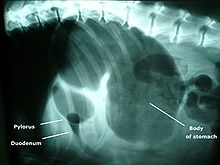胃扩张扭转症
胃扩张扭转症(英语:Gastric dilatation volvulus, GDV),又称为胃扭转(gastric torsion),是一种可能危及生命且必须及时治疗的犬只疾病。成因为犬只胃部因含有过多气体而造成过度拉伸和扭转。GDV在部分犬种(如深胸犬)很常见。即使经过治疗,死亡率也有10%-60%;若进行手术治疗,死亡率则大致为15%-33%[1][2]。

胃扩张扭转症的症状不一定可以明显地与其他疾病分别,犬只可能会在没有明显原因下不舒服地站立。其他可能的症状包括腹部剧烈膨胀、虚弱、抑郁、呼吸困难、过度流涎和干呕。在许多患有GDV的犬只身上也可以发现心律不整 [3]。犬只的慢性胃扩张扭转症症状包括食欲不振、呕吐和体重减轻等 [4]。
成因
编辑犬只胃扩张肠扭转症可能由多种因素引起。但在所有情况下,最直接的条件是食道和胃之间的括约肌功能障碍、以及幽门流出受阻 [5]。其它引起GDV的因素包括年龄、品种、深胸犬、食物在胃中膨胀、过度喂食、在运动前后的一小段时间内摄取大量的水、以及紧迫和其他胃肠道疾病 [6]。患有炎症性肠病的狗可能会增加腹胀的风险 [7]。
过去曾经普遍建议在犬只进食的时候应该要把它们的食物碗抬高;但这实际上可能增加GDV的风险[8]。每天只吃一餐或饲料颗粒小于30 mm(1.2英寸)也可能使罹患GDV的风险提高[9][10]。虽然谷物、大豆和动物蛋白不会增加腹胀的机率,但添加较多油脂或脂肪的饮食确实会增加患病可能,这可能是由于胃排空延迟所致[11]。
病理生理学
编辑在胃扩张扭转症的犬只中,病患胃部环绕著消化道纵轴而扭转。扭转前后都可能发生腹胀[5]。从犬只后侧观察,最常见的扭转方向是顺时针旋转,胃部在这个方向最多可以旋转360°;逆时针旋转则可以到达90°。如果扭转大于180°,食道就会受到挤压而关闭,使犬只无法通过打嗝或呕吐来缓解病情[12]。胃扩张扭转症亦可能造成低血压、血液回流受阻、胃部缺血和休克;门静脉如果受到挤压会减少流向肝脏的血流,并降低该器官从血液中清除毒素和细菌的能力[13]。在胃的另一端,如果扭转中断脾脏血液供应,则可能造成脾脏坏死。如果不迅速治疗,腹胀会导致败血症、腹膜炎,最终导致毒性休克症候群而死亡。
诊断
编辑GDV的诊断取决于几个因素,好发的犬种和病史通常会是严重怀疑罹患这种疾病的原因。理学检查经常会发现明显的腹部鼓胀;休克的诊断依据则是粘膜苍白、微血管填充不良、心率加快或心律不整。影像学检查可见胃部膨胀并充满气体。在正常犬只下,幽门通常位于胃的右腹侧;而GDV的犬只则可见幽门偏移到腹中线的左侧与胃体部的前侧,而胃部在X光下则显现为一个充满空气、分离成两部分的囊袋样构造[4]。
治疗
编辑胃扩张扭转症是一种急症,可能会在短时间内造成死亡;让兽医治疗是绝对必要的。治疗的方式通常包括输液治疗结合急诊手术。急症初期胃部可以通过胃管减压;如果无法通过胃管减压,可以利用套管针穿刺皮肤进入胃部去除气体;或是在麻醉后将套管针直接插入胃中以减少发生感染的机会。在手术过程中,将胃部放回正确位置、并检查腹腔中是否有任何坏死的组织(尤其是胃和脾脏);如果发生胃壁坏死,可能需要进行局部胃切除手术。
预防
编辑GDV的复发是一个可能存在的问题。高达80%只接受药物治疗(未接受手术治疗)的犬只有复发的可能[14]。为了防止复发,在手术治疗的同时经常合并进行右侧胃固定术,通过各种方法将胃壁牢固地附着在体壁上,以防止胃部在腹腔内扭转。虽然进行胃固定术的犬只仍然可能出现腹胀,但胃扭转复发的机会显着减少 [15]。在罹患GDV的高风险族群中,也可以进行预防性胃切除术[14]。
其他有助于预防胃扩张扭转症的措施包括少量多餐、而非全日仅一次大量进食,并且不要在进食前后运动[16]。
预后
编辑即时治疗是预后良好的最重要因素。延迟治疗超过6小时或出现腹膜炎、败血症、低血压或弥散性血管内凝血是预后不良的指标[2]。即使进行治疗,死亡率也接近10%-40%[17]。手术治疗的不良预后指标包括心律失常、脾切除或部分胃切除术。 [18]
流行病学
编辑一般而言,深胸犬罹患胃扩张扭转症的风险最大。风险最大的5个品种是大丹犬、威玛犬、圣伯纳犬、戈登雪达犬和爱尔兰雪达犬[19]。标准贵宾、爱尔兰猎狼犬、德国短毛指针犬、德国牧羊犬、罗得西亚脊背犬、和50磅(23千克)以下的巴吉度猎犬、腊肠犬也面临罹患这种疾病的风险[1]<ref name="Merck"/。
参考资料
编辑- ^ 1.0 1.1 Aronson, Lillian R.; Brockman, Daniel J.; Brown, Dorothy Cimino. Gastrointestinal Emergencies. The Veterinary Clinics of North America. 2000, 30 (1): 558–569. PMC 1374121 . PMID 10853276. doi:10.1016/s0195-5616(00)50039-4.
- ^ 2.0 2.1 Risk factors associated with short-term outcome and development of perioperative complications in dogs undergoing surgery because of gastric dilatation-volvulus: 166 cases (1992-2003). J. Am. Vet. Med. Assoc. 2006, 229 (12): 1934–9. PMID 17173533. doi:10.2460/javma.229.12.1934.
- ^ Canine gastric dilatation/volvulus syndrome in a veterinary critical care unit: 295 cases (1986-1992). J. Am. Vet. Med. Assoc. 1995, 207 (4): 460–4. PMID 7591946.
- ^ 4.0 4.1 Fossum, Theresa W. Gastric Dilatation Volvulus: What's New? (PDF). Proceedings of the 31st World Congress. World Small Animal Veterinary Association. 2006 [2007-04-17]. (原始内容 (PDF)存档于2018-09-23).
- ^ 5.0 5.1 Gastric ulceration subsequent to partial invagination of the stomach in a dog with gastric dilatation-volvulus. J. Am. Vet. Med. Assoc. 2006, 228 (12): 1895–900. PMID 16784379. doi:10.2460/javma.228.12.1895.
- ^ Incidence of and breed-related risk factors for gastric dilatation-volvulus in dogs. J. Am. Vet. Med. Assoc. 2000, 216 (1): 40–5. PMID 10638316. doi:10.2460/javma.2000.216.40.
- ^ Gastric dilatation-volvulus in the dog with histological evidence of preexisting inflammatory bowel disease: a retrospective study of 23 cases. Journal of the American Animal Hospital Association. 1996, 32 (4): 287–90. PMID 8784718. doi:10.5326/15473317-32-4-287.
- ^ Non-dietary risk factors for gastric dilatation-volvulus in large and giant breed dogs. J. Am. Vet. Med. Assoc. 2000, 217 (10): 1492–9. PMID 11128539. doi:10.2460/javma.2000.217.1492.
- ^ Multiple risk factors for the gastric dilatation-volvulus syndrome in dogs: a practitioner/owner case-control study. Journal of the American Animal Hospital Association. 1997, 33 (3): 197–204. PMID 9138229. doi:10.5326/15473317-33-3-197.
- ^ Small size of food particles and age as risk factors for gastric dilatation volvulus in great danes. Vet. Rec. 1998, 143 (2): 48–50. PMID 9699253. doi:10.1136/vr.143.2.48.
- ^ The effect of ingredients in dry dog foods on the risk of gastric dilatation-volvulus in dogs. Journal of the American Animal Hospital Association. 2006, 42 (1): 28–36. PMID 16397192. doi:10.5326/0420028.
- ^ Gastric Dilatation-volvulus. The Merck Veterinary Manual. 2006 [2007-04-17]. (原始内容存档于2016-03-04).
- ^ Bright, Ronald M. Gastric dilatation-volvulus: risk factors and some new minimally invasive gastropexy techniques. Proceedings of the 29th World Congress of the World Small Animal Veterinary Association. 2004 [2007-04-17]. (原始内容存档于2009-04-15).
- ^ 14.0 14.1 Prospective evaluation of laparoscopic-assisted gastropexy in dogs susceptible to gastric dilatation. J. Am. Vet. Med. Assoc. 2002, 221 (11): 1576–81. PMID 12479327. doi:10.2460/javma.2002.221.1576.
- ^ A prospective study of survival and recurrence following the acute gastric dilatation-volvulus syndrome in 136 dogs. Journal of the American Animal Hospital Association. 1998, 34 (3): 253–9. PMID 9590454. doi:10.5326/15473317-34-3-253.
- ^ Wingfield, Wayne E. Veterinary Emergency Medicine Secrets. Hanley & Belfus, Inc. 1997. ISBN 978-1-56053-215-6.
- ^ Bloat. aspca.org. The American Society for the Prevention of Cruelty to Animals. [15 October 2017]. (原始内容存档于July 1, 2014).
- ^ A retrospective study of factors influencing survival following surgery for gastric dilatation-volvulus syndrome in 306 dogs. Journal of the American Animal Hospital Association. March–April 2010, 46 (2): 97–102. PMID 20194364. doi:10.5326/0460097.
- ^ Analysis of risk factors for gastric dilatation and dilatation-volvulus in dogs. J. Am. Vet. Med. Assoc. 1994, 204 (9): 1465–71. PMID 8050972.